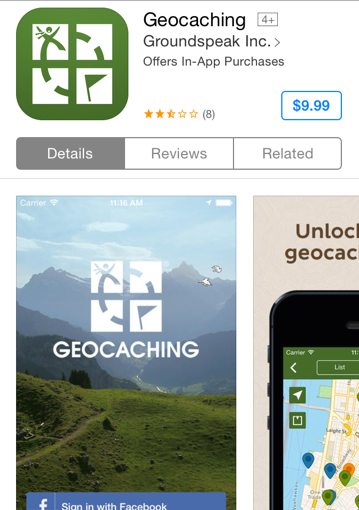
A screenshot of the app. Credit: Courtesy of Groundspeak Inc.
Who doesn’t secretly want to fulfill their childhood dream of going on a treasure hunt? The Geocaching Club at Ohio State, which began this fall, does just that.
Geocaching is essentially a giant scavenger hunt, aided by a GPS, said Matthew Bezold, a fourth-year in accounting and president of the club. Participants use the GPS in their phones along with an app to track and find hidden “treasures,” called geocaches, which are generally small packages containing an item inside.
“You have an idea of the size of the container and its approximate location, and then you have to find it,” he said. “It’s cool. You find this container, and then when you open it, there’s always a log to see all the people that have already found it.”
Bezold said that geocaches feature small trinkets that the geocacher can take, as long as they put something else in its place.
“It’s important that if you take something, you put something of approximate value back, otherwise it’s not as fun,” he said. “The best part about geocaching is the adventure and the creativity, because some owners can get really into it.”
Bezold said prospective treasure hunters can either download the official geocaching app, Geocaching by Groundspeak Inc., or they can go onto geocaching.com and sign up for free.
“You create a username and then there are coordinates for various containers. Input those coordinates into a GPS, and then you try to find them,” said Ben Hufford, a second-year in accounting and treasurer of the Geocaching Club.
Hufford said that the objects a geocacher is seeking are rated from one to five, according to difficulty, so those new to the treasure hunt and seasoned veterans can be entertained and engaged.
“Geocaching is a great combination of technology and the outdoors.” Bezold said. “If you like adventure and having fun, then geocaching is definitely for you.”
OSU’s geocaching club, which is in its first official semester, has had three events so far and welcomes new members.
“We don’t have set meetings, so I’ll just post in the Facebook group about an upcoming hunt,” Bezold said.
The club also met for a special “Night Cache” in Walnut Street Park on Nov. 19. “This is a unique type of cache because, as the name implies, it can only done in the dark,” Bezold said.
To complete the hunt, the geocachers had to follow a path of reflectors by shining a flashlight on them. Some of the reflectors were missing, which made the game a bit more difficult.
Eventually Bezold found the cache — a large ammo container near a tree marked with reflectors.
This is one example of a hunt, and all of the hunts are different. Bezold said his favorite hunt reminded him of the movie “National Treasure.”
“I had to go to various sites and solve puzzles. I eventually found a gold spray-painted box filled with ‘treasure,’” he said.
Hufford said on his most memorable hunt, his parents joined him. He took them out and they discovered a geocache with a dog harness that he said fit his dog perfectly.
There are currently more than 419 geocaches in the Columbus area and over 40 on campus, so the possibility of finding “treasure” exists.
“Each geocache is just so different — the hiding spot, the container, the way (the owner) camouflages it,” Bezold said. “It’s never the same.”


